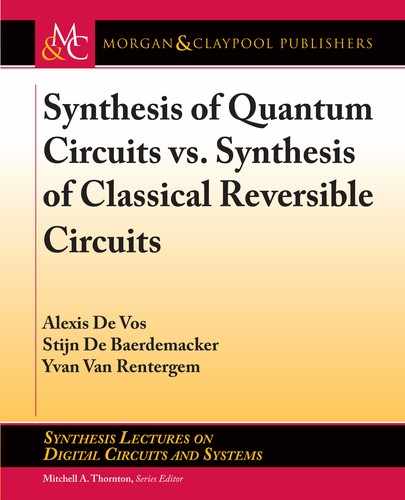3.8. GROUP HIERARCHY 65
We finally remark that the ZXZ theorem allows us to conclude that the closure of the
groups XU(n) and ZU(n) is the group U(n). If n is even, we have the identity
diag.a; a; a; a; a; : : : ; a; a/ D P
0
diag.1; a; 1; a; 1; : : : ; 1; a/ P
1
0
diag.1; a; 1; a; 1; : : : ; 1; a/ ;
(3.16)
where a is a short-hand notation for e
i˛
and P
0
is the circulant permutation matrix
0
B
B
B
B
B
B
B
@
0 1 0 0 : : : 0 0
0 0 1 0 : : : 0 0
0 0 0 1 : : : 0 0
:
:
:
0 0 0 0 : : : 0 1
1 0 0 0 : : : 0 0
1
C
C
C
C
C
C
C
A
;
called the cyclic-shift matrix [9, 60]. If n is odd, then we have analogously
diag
.a; a; a; a; a; : : : ; a; a/
D
P
0
diag.1; a; 1; a; 1; : : : ; a; 1/ P
1
0
diag.1; a; 1; a; 1; : : : ; a; 1/ :
us, for all n, the factor e
i˛
in (3.14) can be decomposed into two XU(n) matrices and two
ZU(n) matrices. We can conclude that every unitary matrix equals the product of three or less
XU(n) members and three or less ZU(n) members. is conclusion is reminiscent of the result
in Section 2.3: every permutation matrix is the product of three or less P
x
(n) members and three
or less P
z
(n) members.
3.8 GROUP HIERARCHY
We may summarize above sections by noting the beautiful symmetry
ZU.n/ Š U.1/
n1
and XU.n/ Š U.n 1/
1
:
Analogous to the group hierarchy
1.n/ P.n/ XU.n/ ;
we can construct a hierarchy
1.n/ Q.n/ ZU.n/ ;
by introducing the finite group Q(n). Like P(n) consisting of all XU(n) matrices with integer
entries, we define Q(n) as the group consisting of all ZU(n) matrices with exclusively integer
entries. us, an arbitrary Q(n) matrix is a diagonal matrix with upper-left entry equal to 1 and
all other diagonal entries equal ˙1. e group is isomorphic to S
n1
2
and has order 2
n1
.
e closure S(n) of the groups P(n) and Q(n) consists of all n n matrices with one ˙1 in
each row and in each column. e group is called the signed permutation group and has order

66 3. BOTTOM-UP
nŠ2
n
. One can easily prove that any member of S(n) can be decomposed as the product of at
most two Q(n) matrices and two P(n) matrices.
We close the present chapter with Figure 3.3, a more detailed and elaborate version of
both Figure 1.2 and Figure 3.2. e orders of the groups are displayed in Figure 3.4.
S(?)
U(?)
P(?)
XU(?)
Q(?)
ZU(?)
1(?)
Figure 3.3: Hierarchy of the Lie groups U(n), XU(n), and ZU(n) and the finite groups S(n),
P(n), Q(n), and 1(n).
?!2
?
∞
?
2
?!
∞
(?–1)
2
2
?–1
∞
?–1
1
Figure 3.4: Orders of the Lie groups U(n), XU(n), and ZU(n) and the finite groups S(n), P(n),
Q(n), and 1(n).
..................Content has been hidden....................
You can't read the all page of ebook, please click here login for view all page.
